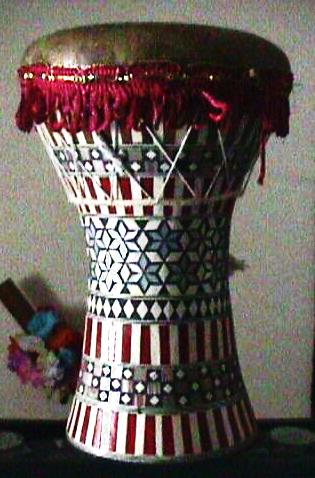Tablas and Other Drums
Since Middle Eastern music is formed by combining a melodic mode and a rhythmic mode drums are very important to the creation of a complete song. The drum provides the rhythmic backbone for nearly all Middle Eastern Music. It's often described as its heartbeat. The rhythms played on the drum are one of the most important elements of music for Middle Eastern dancers, who follow their cues largely from the various rythym patterns, which they shimmy, thrust, and twist to. There are several types of drums used in Middle Eastern music. Most are hand drums and the most common type is a single-headed drum.
The Tabla is arguable the most common of these single-headed drums. It is a goblet shapped drum that is generally laid on it side over one leg when sitting or nestled between one arm when played standing. There are a number of regional variations including the name. They are known as طبلة "Tabla" (the general Arabic word meaning drum), دربوكة "Darbouka" (stemming from the Arabic word darab meaning to hit or strike), تمبک "Tombek" (Farsi/Persian meaning drum, also spelled "Doumbek" in some transliterations), and ضرب "Zarb" (Farsi/Persian for "beat" or strike"). The Djembe is a similar drum found in Sub-Saharan Africa but the Tabla usually has a rounded rim which allows the drummer to roll the fingers and create "filling" in the rhythm patterns. Some Persian and Turkish styles do not have rounded rims but are generally played the same way. Sometimes Persian musicians wear metal rings on the fingers so that they can strike them against the rim to create a similar type of "filler" in the pattern. No matter which type you are using the same basic rhythm patterns can be played on all of them. There is a different type of drum used in India that is called a Tabla but it is more similar to a set of Bongo drums and is unrelated to the goblet style drums used in Middle Eastern music.
To read more about Middle Eastern Tablas please visit these additional pages on our site.
 Learn about the history and development of the Tabla as well as information on their construction, differences, buying
Learn about the history and development of the Tabla as well as information on their construction, differences, buying
 tips and more.
tips and more.
 Learn how to take care of your Tabla. Tips for adjusting, tightening, and replacing your drum's head, cleaning, and
Learn how to take care of your Tabla. Tips for adjusting, tightening, and replacing your drum's head, cleaning, and
 even how to make minor repairs.
even how to make minor repairs.
 Learn how to play your Tabla and disover the variety of Rhythms you can learn.
Learn how to play your Tabla and disover the variety of Rhythms you can learn.


